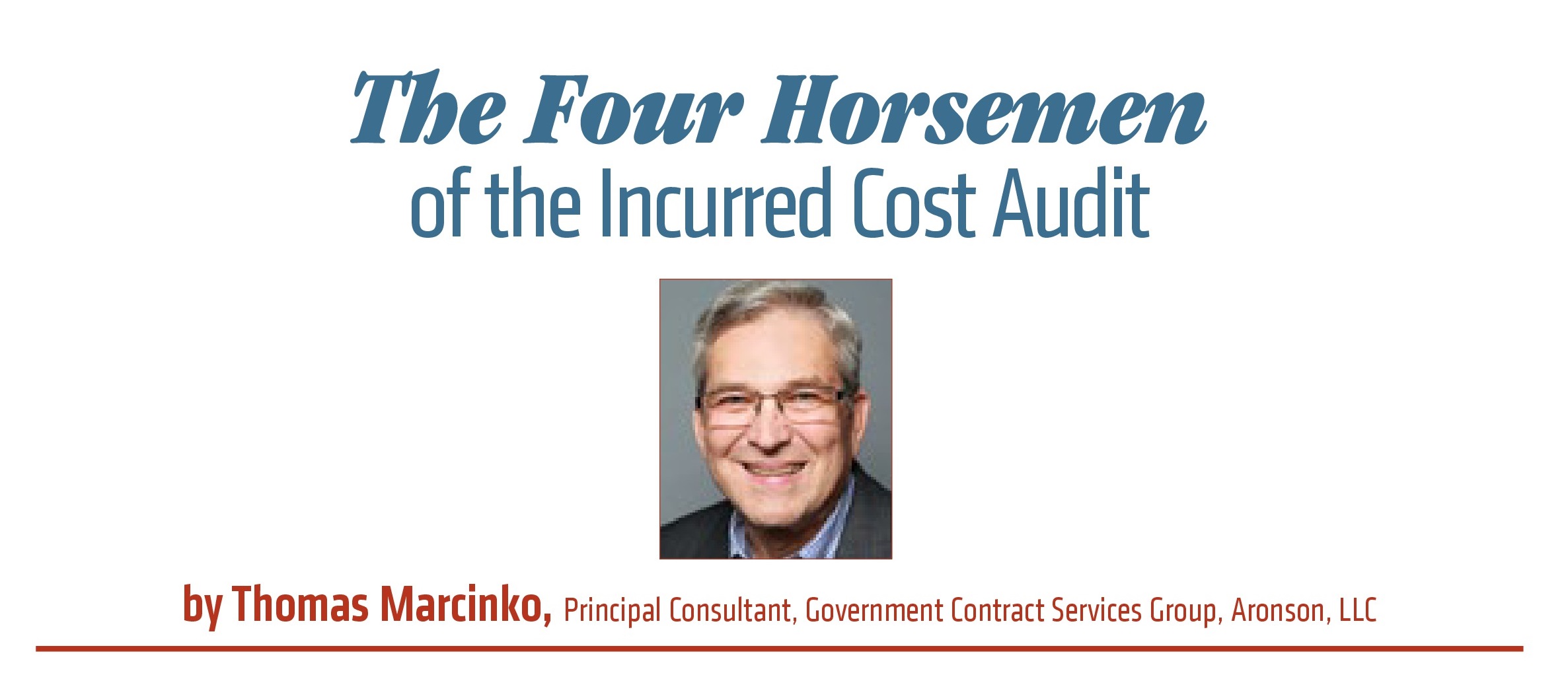
The Four Horsemen of the Incurred Cost Audit
By Thomas Marcinko, Principal Consultant, Government Contract Services Group
Aronson, LLC
Under the Allowable Cost and Payment clause, contractors with flexibly priced contracts are required to submit an annual final indirect cost rate proposal, (known as an incurred cost submission), which is the precursor to the government’s incurred cost audit. One of the primary purposes of an incurred cost audit is to ensure the contractor has not included any unallowable costs in their indirect cost pools.
The noted sports journalist Grantland Rice once famously compared four Army football players to the four horsemen of the apocalypse. If Grantland were alive today and covering government contracting he might have used his colorful language to describe the four horsemen of the incurred cost audit: consulting fees, automobile expenses, executive compensation and bonuses. These cost elements, which are considered to be “low hanging fruit” by the Defense Contract Audit Agency (DCAA), represent the lion’s share of the indirect costs disallowed in the typical incurred cost audit. Though well short of apocalyptic, cost disallowances in these areas, occasionally reaching millions of dollars, can be financially traumatic for the contractor.
There is nothing wrong with incurring an unallowable cost. Most large Department of Defense contractors knowingly exceed the executive compensation ceiling. These contractors book the amount in excess of the compensation ceiling to an unallowable account so those costs are not billed to the government.
The problem arises when contractors charge the government for costs that are deemed unallowable years later during the incurred cost audit. This introduces the risk of a Civil False Claims Act violation which will entail penalties and interest in addition to refunding the cost. In addition, the cost disallowances and any penalties and interest are reflected in the contractor’s books for the current year, which means the current management team is taking a financial hit for unallowable costs incurred and billed years ago. Conversely, the financial reports for the year in which the unallowable costs were incurred, based on the assumption they were allowable, presented an overly rosy picture of the contractor’s profitability.
In some cases, costs are without question unallowable. However, in many cases otherwise allowable costs are disallowed because the contractor failed to prepare or retain adequate supporting documentation. This article provides practical tips contractors can use to ensure fees paid to consultants, automobile expenses, executive compensation, and employee bonuses will be deemed allowable. Or in the alternative, to make an informed decision to incur an unallowable, unbillable cost knowing it will result in a reduction to the company’s profit for the year.
Consulting Costs
The allowability of fees paid to a consultant is addressed in FAR 31.205-33 “Professional and Consulting Consultant Service Costs.” Professional and consultant services are defined as services rendered by persons who are members of a particular profession or possess a special skill and who are not officers or employees of the contractor. Consulting services are generally acquired to obtain information, advice, opinions, alternatives, conclusions, recommendations, training, or direct assistance, such as studies, analyses, evaluations, liaison with Government officials, or other forms of representation.
Consulting costs are generally allowable as long as they are supported by evidence of the nature and scope of the service furnished. The cost principle defines the required evidence to be:
- An agreement with the consultant that includes a detailed scope of work, the rate of compensation and the amount of other expenses to be reimbursed;
- Invoices submitted by the consultant with sufficient detail as to the time expended and the services provided; and
- Consultant’s work product such as trip reports, meeting minutes and other deliverables.
Consulting costs are frequently deemed unallowable solely because the contractor did not produce or retain the required documentation. Consulting costs incurred under a verbal agreement will almost certainly be unallowable. Consulting agreements with abbreviated scopes of work such as “business development support” or invoices that merely state “for services rendered” are also problematic.
DCAA has changed their audit guidance to stress that it is the substance of the documentation that is important, not the title . This change offers a contractor more flexibility in supporting consulting costs, though the safest approach is to develop the required supporting documentation exactly as described in the cost principle. Such documentation should include a fully executed consulting agreement featuring a detailed scope of work, a period of performance, rates of compensation and a termination provision.
To be considered allowable, payment of the consulting fees cannot be contingent on recovery of the costs from the Government. Out-of-scope services, services performed outside the period of performance or fees in excess of the consulting agreement rates are unallowable. This means the consulting agreement may need to be amended as the work progresses to reflect any changes in scope, period or rates. Also, the costs of consulting services that violate a law or regulation will never be allowable.
A consultant’s invoice should describe the work accomplished for the period. In most cases, a descriptive paragraph on the invoice will suffice. Deliverables such as reports, presentations, meeting minutes, etc. can be included with the invoice or referenced on the invoice and submitted separately. The contractor should also have evidence the consultant was qualified to provide the services and the fees were reasonable.
In addition to generating documentation at the time the consulting services are obtained, the contractor must be able to produce it many years later during the incurred cost audit. To be able to consistently develop the required documentation, retain it, and then produce it during the incurred cost audit requires implementing a formal process backed by a written policy and procedure.
Automobile Expenses

It is common for contractors to provide their key executives with automobiles or at least an automobile allowance. It is almost as common to see automobile expenses questioned during an incurred cost audit. The allowability of automobile expenses is addressed in two cost principles. FAR 31.205-6, Compensation for Personal Services, states the “portion of the cost of company-furnished automobiles that relates to personal use by employees (including transportation to and from work) is unallowable …”
FAR 31.205-46, Travel Costs, states the “Costs of contractor-owned or leased automobiles …. include the costs of lease, operation, maintenance, depreciation, insurance, etc. These costs are allowable, if reasonable, to the extent that the automobiles are used for company business.”
These cost principles are easy to reconcile if the automobile expense is solely for business or personal use. However, in many cases the automobile is driven by the employee for both business and personal reasons. Therefore, the employee must maintain a log of all business use, including mileage and the business purpose or the trip. In addition, all related expenses such as maintenance must be documented. If at year-end the log shows that the automobile was used ½ for business and ½ for personal use, then ½ of the costs must be charged to an unallowable account. If a log is not maintained, DCAA will be within their rights to question the entire cost of the automobile even if is likely at least some of the use was for business.
However, demonstrating the extent of business use and maintaining records are not the only requirements for allowability of automobile expenses. The travel cost principle also limits the allowability to reasonable costs. Per the FAR, “A cost is reasonable if, in nature and amount, it does not exceed that which would be incurred by a prudent person in the conduct of competitive business. .”
Though not reflected in any published audit program or guidance, DCAA has taken the position that automobile costs exceeding the cost of the best sellingbest-selling cars in the U.S. are unreasonable and therefore, unallowable. This position, though likely popular with the taxpayer, is inconsistent with the FAR’s definition of a reasonable cost. Based on the traffic in Washington D.C., few prudent businessmen in competitive businesses are driving Toyota Camrys or Ford Fusions. That said, when DCAA takes this position, it can be difficult to argue that the taxpayer should reimburse the contractor’s Mercedes or BMW. When a company car is to be provided to an employee, the company would be well advised to calculate the cost of providing a Fusion or Camry because the costs in excess of that might be disallowed.
Executive Compensation

Contractors are required to report their executive compensation on Schedule B of the incurred cost submission. The fact that executive compensation has its own schedule shows it is an important part of an incurred cost audit. This is especially true for principals in closely held firms.
The allowability of executive compensation is addressed in the “Compensation for Personal Services” cost principle. An analysis of all potential components of compensation is beyond the scope of this article but salary and bonus will be included. The cost principle holds that allowable executive compensation will be the lesser of the statutory ceiling, currently $487,000, or the amount that DCAA determines to be reasonable.
However, setting executive compensation at less than the statutory ceiling is not necessarily a safe harbor as DCAA can still find the compensation to be unreasonably high. DCAA will make this determination by comparing the actual compensation to salary surveys. This comparison usually involves three salary surveys and at least three variables, the size, type and sometimes location of the company, mapping the contractor’s job title to the salary survey categories and the applicable percentile of the salary survey. DCAA will take the average total compensation derived from the salary surveys and add a 10% “fudge factor.” Compensation that exceeds the average of the salary surveys plus 10% will be questioned.
This calculation is inherently subjective and contractors can push back. For instance, in some cases an argument can be made that, based on the job description instead of the position title, the position is not mapped correctly to the salary survey. DCAA also defaults to the 50th percentile. DCAA will use the 75th or 90th percentile if the contractor can prove, through verifiable financial ratios, that their performance far exceeds the industry average. It is also possible the contractor can cite a salary survey not considered by DCAA that is more supportive of their position.
The weakness of this reactionary approach is the contractor has allowed DCAA to set the parameters of the debate and the contractor must prove DCAA is wrong. DCAA, like most organizations, does not like to be proved wrong. There is a better way to maximize the allowability of executive compensation. During an incurred cost audit, the contractor will be asked to describe the process used to established the amount of executive compensation. A response like “Our HR Director is very experienced with the labor market in this area” is not a process. Nor is it likely to be documented.
Ideally, contractors will mimic DCAA’s approach to justify their executive compensation. Prior to determining the compensation for the year, contractors should use salary surveys or compensation consultants and any other pertinent information to demonstrate the executive compensation is within industry norms. This analysis may show some semantic disconnects which can be resolved by revising job titles or descriptions to more accurately reflect the executive’s duties and more closely align with the pertinent, read desirable, salary survey position. This process and the resulting analysis should be documented and provided to DCAA when requested. This shifts the debate by 180 degrees. Now DCAA will have to prove the contractor’s analysis is wrong. Contractors have a much better chance of winning that argument.
Bonuses

Bonuses are part of executive compensation for the purpose of exceeding the overall statutory and reasonableness requirements. However, even if the executive compensation is deemed to be allowable, the bonus element can still be questioned based on other requirements.
The Compensation for Personal Services cost principle states that bonuses are allowable provided the awards are based on an employment agreement entered into before the services were rendered or pursuant to an established plan or policy followed consistently by the contractor. Therefore, absent specific employment agreements, for bonuses to be allowable, contractors will need to have a written bonus plan. The bonus plan must address who is eligible to receive a bonus, when the bonus will be paid and how the amount will be calculated.
The basis of the bonus award must be supported in writing for each employee receiving a bonus. Though some subjectivity is acceptable, to the greatest extent possible bonuses should be based on the achievement of measurable objectives. Contractors cannot turn profit into a cost by distributing it to employees. While contractors may make bonuses contingent on the company turning a profit, contractors must be careful not to tie the actual bonus calculation too specifically to profitability.
DCAA will question the entire bonus if the contractor does not have a written bonus plan, or if the basis of award is not documented, or if DCAA believes the bonus represents a distribution of profit. This is true even if DCAA has determined that the overall executive compensation, including the bonus, is reasonable.
Conclusion
Too often incurred costs audits are full of bad surprises and become a painful, money losing exercise for the contractor that could have easily avoided with a little foresight and preparation. There is no good reason for having consulting costs and bonuses disallowed due to the lack of relatively easy to prepare documentation. On the other hand, there may be good business reasons, such as recruiting and retention, to incur unallowable automobile costs and executive compensation. The results of the incurred cost audit should not be a surprise to the contractor who plans and prepares.
--This article appeared in the Spring 2018 Service Contractor Magazine. Click here to view the PDF version of this article--